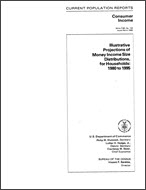Illustrative Projections of Money Income Size Distributions, for Households: 1980 to 1995
Illustrative Projections of Money Income Size Distributions, for Households: 1980 to 1995
In the 1980 census, the Bureau plans to discontinue the use of the terms "head of family" and "head of household." In this report, the term "householder" has been used in place of the term "head." Further discussion of this change can be found in the section, "Head versus householder."
Introduction
This report contains illustrative projections of income distributions for households by type of household and age of householder. No attempt has been made to forecast changes in income or its distribution. The tables contain income distributions for various sets of assumptions. The user can prepare income distribution forecasts by forecasting mean household income growth rates and then choosing the projected distributions which most nearly conform to these forecasts. The report updates similar information contained in Current Population Reports, Series P-23, No. 4 7, Illustrative Projections of Money Income Size Distributions for Families and Unrelated Individuals, which was published in 1974.
Projections have been prepared for all households, family households, husband-wife households, and nonfamily households by age of the householder for the years 1980, 1985, 1990, and 1995. For each of the years, separate projected distributions are shown for assumed annual growth rates of 0.0, 1.0, 1.5, 2.0, 2.5, 3.0, and 4.0 percent. These rates were chosen for illustrative purposes only and do not necessarily demarcate the range of reasonable future growth. Growth in real mean income has been in the 1- to 3-percent range during the past 20 years. All of the projections were made using Series II national population projections.1 In addition to the projected number of units in each income interval, the tables also contain projected aggregate income for the same income intervals and a percent distribution for each of the above.
It should be noted that the income intervals and income amounts refer to dollars of 1977 purchasing power. Thus, the differences in the projected income distributions compared to those for 1977 are "real" in that they do not reflect any reduction in the purchasing power of the dollar resulting from inflation. Projections such as these are called "constant dollar" projections because they assume that the purchasing power of the dollar remains constant over the projection period. "Current dollar" projections, on the other hand, would add an additional factor for inflation and would yield projected distributions in terms of the purchasing power of the dollar in the projected year.
The difference between current dollar and constant dollar projections can be illustrated by comparing the change in mean family income between 1957 and 1977. During this 20-year period, mean family income measured in constant dollars increased at an average annual rate of about 2.2 percent per year. If in 1957, one had made a projection for 1977 in terms of dollars of 1957 purchasing power, assuming a 2.2 percent per year growth rate for mean family income, the projected amount would have been about $8,400. However, because prices also increased during this period, estimated 1977 mean family income when measured early in 1978 was about $18,300. The difference between the projected amount of $8,400 in 1957 dollars and the estimated amount of $18,300 in 1977 dollars does not reflect any difference in total purchasing power, but rather reflects inflation which occurred between 1957 and 1977. Looking ahead, one can expect the same type of differences to occur with these projections, although the magnitude of the difference will depend on the number of years being projected and future rates of inflation. Thus, for example, the 1985 current dollar mean family income when actually measured in 1985 will probably be somewhat greater than our projected amounts which are in 1977 constant dollars.
__________
1 See Current Population Reports, Series P-25, No. 704 (July 1977) and No. 805 (May 1979) for details of methodology used to estimate numbers of households by age and type.
A Note on Language
Census statistics date back to 1790 and reflect the growth and change of the United States. Past census reports contain some terms that today’s readers may consider obsolete and inappropriate. As part of our goal to be open and transparent with the public, we are improving access to all Census Bureau original publications and statistics, which serve as a guide to the nation's history.
Others in Series
Publication
Publication
Publication




